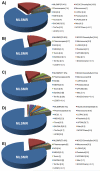Quantitative analyses of aggregation, autofluorescence, and reactivity artifacts in a screen for inhibitors of a thiol protease
- PMID: 19908840
- PMCID: PMC2992957
- DOI: 10.1021/jm901070c
Quantitative analyses of aggregation, autofluorescence, and reactivity artifacts in a screen for inhibitors of a thiol protease
Abstract
The perceived and actual burden of false positives in high-throughput screening has received considerable attention; however, few studies exist on the contributions of distinct mechanisms of nonspecific effects like chemical reactivity, assay signal interference, and colloidal aggregation. Here, we analyze the outcome of a screen of 197861 diverse compounds in a concentration-response format against the cysteine protease cruzain, a target expected to be particularly sensitive to reactive compounds, and using an assay format with light detection in the short-wavelength region where significant compound autofluorescence is typically encountered. Approximately 1.9% of all compounds screened were detergent-sensitive inhibitors. The contribution from autofluorescence and compounds bearing reactive functionalities was dramatically lower: of all hits, only 1.8% were autofluorescent and 1.5% contained reactive or undesired functional groups. The distribution of false positives was relatively constant across library sources. The simple step of including detergent in the assay buffer suppressed the nonspecific effect of approximately 93% of the original hits.
Figures






References
-
- Austin CP, Brady LS, Insel TR, Collins FS. NIH Molecular Libraries Initiative. Science. 2004;306:1138–9. - PubMed
-
- Inglese J, Johnson RL, Simeonov A, Xia M, Zheng W, Austin CP, Auld DS. High-throughput screening assays for the identification of chemical probes. Nat Chem Biol. 2007;3:466–79. - PubMed
-
- McGovern SL, Caselli E, Grigorieff N, Shoichet BK. A common mechanism underlying promiscuous inhibitors from virtual and high-throughput screening. J Med Chem. 2002;45:1712–22. - PubMed
-
- McGovern SL, Helfand BT, Feng B, Shoichet BK. A specific mechanism of nonspecific inhibition. J Med Chem. 2003;46:4265–72. - PubMed
-
- Feng BY, Shelat A, Doman TN, Guy RK, Shoichet BK. High-throughput assays for promiscuous inhibitors.[see comment] Nature Chem Biol. 2005;1:146–8. - PubMed
Publication types
MeSH terms
Substances
Grants and funding
LinkOut - more resources
Full Text Sources
Other Literature Sources
Chemical Information

